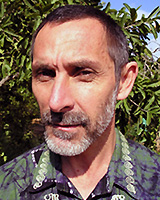Background
Neonatal resuscitation is an essential skill in maternal and child health. Outcomes for newborns can be markedly improved if the doctor and midwife have appropriate neonatal resuscitation skills.
It is well documented that the resuscitation skills of doctors and nurses in rural or frontline facilities1,2, and even in teaching hospitals3,4, are often inadequate. This applies in no less measure to skills in neonatal resuscitation amongst staff working in maternity units in district hospitals in South Africa.
There is a national awareness in South Africa of the problem and there are several initiatives underway to address this skills gap. However most of these initiatives reach health workers in urban areas near tertiary centres while there is a great need to upgrade the skills of rural health workers in neonatal resuscitation.
The Family Medicine Education Consortium (FaMEC) is developing primary care clinical training in districts throughout the country. Training complexes are being developed in all the provinces, with a special focus on rural and underserved areas. One of the focus areas is to deliver specific skills training for doctors working in these districts.
FaMEC represents the eight departments of family medicine and three rural health units in South Africa. It is engaged in a project to develop district-based primary care training funded by the Flemish Interuniversity Council (VLIR) in Belgium. In this regard it works in collaboration with a network of partners including the national department of health, the South African Academy of Family Practice/Primary Care and the Rural Doctors' Association of Southern Africa.
Contacts within the international rural health network led to a paediatrician-trainer from Australia (JT) being supported to come to South Africa to do training in neonatal resuscitation. JT works for the General Practice and Primary Health Care Northern Territory (GPPHCNT), previously known as Northern Territory Rural Workforce Agency (NTRWA), which supports and trains doctors for rural and remote areas in Northern Territory, Australia. The Rural Workforce Agency of Victoria (RWAV) together with GPPHCNT covered the salary and international travel costs of the trainer, enabling him to come to South Africa for 3 months to do this training. This was a way of giving something back to the development of health services in South Africa in response to doctors from this country working in rural areas in Australia, as recommended by the Melbourne Manifesto on ethical international recruitment of health care professionals5.
Costs within South Africa were borne by the FaMEC primary care training project. The initial plan was that participants would pay a standard fee for the course to off-set the costs of local travel, accommodation, venues, catering, certificates and booklets. In most areas the provincial health departments or local hospitals paid these costs on behalf of the participants.
The project had the following aims:
- To train doctors and nurses in underserved rural and urban areas in neonatal resuscitation.
- To train suitable, appropriate doctors and nurses as trainers in neonatal resuscitation.
- To establish ongoing training in neonatal resuscitation in rural hospitals in South Africa.
- To use the project as a trial of focused skills training through the FaMEC network in order to plan other skills training interventions.
Implementation of the project
Logistics
Through the eight family medicine departments in South Africa, co-ordinators were identified in eight of the nine provinces. Each province was allocated a period of 1-2 weeks for training courses to be conducted.
The provincial coordinators made local arrangements for the courses, making the course known and arranging for participants and venue, equipment and catering. They selected key doctors (usually family physicians) and nurses (midwives) who would be suitable as trainers, to undergo accreditation as trainers. These trainers then arranged courses at their own hospitals.
Preparatory discussions were held with the South African Paediatric Association and the Resuscitation Council, in order to ensure support and synergy. The Faculty of Health Sciences, University of the Witwatersrand, appointed JT as a visiting lecturer in rural health.
JT came with one a complete mannequin that could also be used for all training, including intubation. FaMEC bought a neonatal mannequin and a head for intubation training which ensured that at least two mannequins were available for each course.
Other equipment needed was provided by the local hospitals (Fig 1). The equipment used in the courses was the same as that expected to be used in maternity units in the hospitals. This brought to light serious deficiencies in neonatal resuscitation equipment in rural hospitals. The course made many managers aware of this problem and interventions are already in place for improving this. In some provinces the course led to the development of a standard list of equipment that is needed in each district facility and hospital.
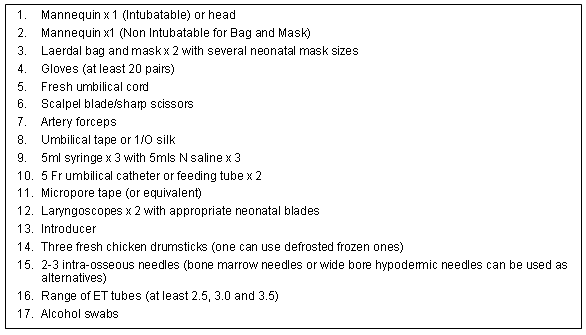
Figure 1: Equipment for the Neonatal Resuscitation Course.
Structure and content of the courses
The Neonatal Resuscitation Course consisted of the following components:
- A pre-course multiple choice question (MCQ) paper
- A series of lecture presentations covering:
- Physiology of the newborn
- Anticipation of resuscitation needs
- Preparation of delivery
- Evaluation
- Techniques of resuscitation
- Medications
- Special resuscitation circumstances
- Post-resuscitation issues
- Ethics
- Physiology of the newborn
- Several skill stations:
- Bag and mask resuscitation
- Endotracheal intubation
- Insertion of an umbilical catheter
- Insertion of an intraosseous line
- Chest compressions
- Bag and mask resuscitation
- Scenarios: practical sessions based on a series of 14 possible scenarios
- A post-course MCQ paper
- Pre- and post-course skills assessment on bag and mask, which was added during implementation in South Africa.
The Training of Trainers Course consisted of the following components:
- Discussion on the principles of adult learning
- A series of presentations on how to teach skill stations and scenarios
- How to give a lecture
- Practice teaching skill stations and scenarios
- A practice lecture
- How to conduct small group training
JT developed the Neonatal Resuscitation course de novo, along the lines of other advanced life support training programmes. The Training of Trainers Course was based on material developed by RWAV and by Dr David Campbell, an Australian GP emergency medicine trainer.
The pre-course reading was the South African Manual of Resuscitation of the Newborn, produced by the South African Paediatric Association (SAPA) and endorsed by the South African Resuscitation Council.
FaMEC and SAPA, as well as the two Australian partners accredited the course.
The Resuscitation Council of South Africa indicated its support of the course and endorsement of the pre-reading booklet.
There were three kinds of certificates issued: certificates of attendance for the neonatal resuscitation and trainers' courses, and certificate of accreditation as a trainer. To achieve the latter, the trainer had to complete the first two courses and then successfully present his/her own course, together with the trainer.
Collaboration
The collaboration between different stakeholders was very good and encouraging. The national and provincial departments of health were fully supportive of the training programme. In many instances, the provincial health department funded the local costs of the training and paid towards the national costs.
The collaboration between FaMEC and SAPA provides a good example of how professional organisations can collaborate towards training of healthcare workers.
A number of university departments of paediatrics and paediatricians in several regional hospitals participated in the training and assisted in some instances.
Primary care nurse trainers were also involved. In Mpumalanga province, the coordinator of primary healthcare nurse training was responsible for facilitating the programme.
Nurses and doctors were trained together, which is also in line with an interdisciplinary team approach towards health care.
Results
Thirty-seven neonatal resuscitation training courses were held in 28 different sites, training 415 people. These included 215 nurses, 192 doctors, and eight paramedics; three medical students took part as observers (Table 1).
Table 1: Attendees on Neonatal Resuscitation Courses
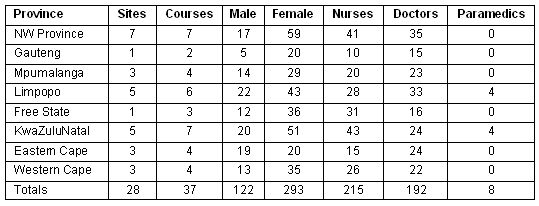
Twelve 'Train the Trainer' Courses were conducted, training 97 people (Table 2).
Table 2: Summary of Train the Trainer Courses. Places and people
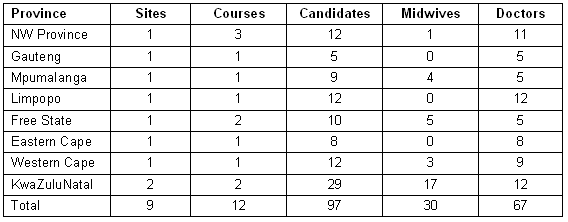
Feedback of participants
Written feedback was obtained from all the participants on their experiences of the course, on the individual sessions and on general issues. The responses were anonymous. A very high degree of satisfaction was reported for all the courses and the individual sessions. Only those sessions, which could not be done in full due to time constraints, had a slightly lower score.
The evaluation form requested asked the participants to score each session out of 5, with 5 = Excellent and 1 = Poor
The General Course Satisfaction rating was high (Fig 2). The evaluation form also asked participants to indicate if they were satisfied with the course (yes/no); all those who answered the question, even the person who gave the course a rating of 2, responded affirmatively.
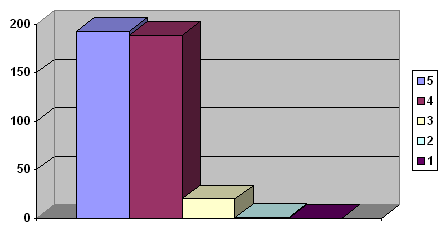
Figure 2: Overall course satisfaction.
Participants were also asked to evaluate the skills stations, viz:
- Bag and mask resuscitation
- Endotracheal intubation
- Insertion of an umbilical catheter
- Insertion of an intraosseous needle
(Chest compressions were taught, but were not evaluated.)
These skills stations were similarly scored from 5 to 1. The scores for all the skills stations combined were very positive (Fig 3).
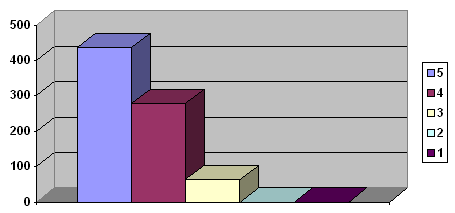
Figure 3: Evaluation of skills stations.
Finally, participants were asked whether they felt more confident in resuscitation. There were 386 positive responses out of 393, representing 92% of all people who did the course and 98% of people who answered the question. The participants who answered negatively, often added a rider saying that more practice was needed. One indicated s/he was a consultant paediatrician, and thus already confident.
Participants in the Train the Trainer Course also expressed high levels of satisfaction.
Pre- and post-course tests
Participants completed a pre- and post-course MCQ test, except one course in KwaZuluNatal where no one completed the post-test and another four people left before the end of their course. Three people did not do the pre-test, because of their extreme late arrival.
Thus 399 candidates completed both the pre- and post-course MCQ tests. The pre-course mean score was 57.21% (95% CI 54.8-59.62%) with a range of 20% to 88.6%. The post-course average was 67.79% (95% CI 65.65-69.91) with a range 30% to 97.5%. The range of difference between the pre- and post-course test was - 22.5% to +55%. Thus there was a significant improvement. As a general rule, medical officers scored higher than the nursing staff.
The Bag and Mask Skills Station pre- and post-course test was introduced halfway through the project. The maximum score was 10. The test was done by 122 candidates, 58 in KwaZuluNatal and 64 in the Eastern and Western Cape. In KwaZuluNatal the pre-course mean score was 2.7 (95% CI 2.2-3.3), with a range of 0 to 10. The post-course mean score was 8.9 (95% CI 8.6-9.2), with a range of 6 to 10. In the two Cape Provinces the candidates had a pre-course mean of 3.4 (95% CI 2.8-3.9), with a range of 0 to 7.5 and a post-course mean of 8.8 (95% CI 8.5-9.2), with a range of 5 to 10. Both of these thus demonstrate significant improvements.
The process of the project
It was an extremely busy and active 3 months for the trainer. The schedule was very full and each province made maximum use of the time available. The organisers did not realise how busy each provincial schedule would be and proper time for rest was not planned.
In many places the equipment, for instance laryngoscope blades, was not adequate for training. This reflects the general problem with neonatal resuscitation equipment.
On the whole, organisation was good in terms of transport, accommodation and course arrangements. In some places the venues were too small for the course. Time keeping by participants, interruptions and too many participants hampered some of the courses. Email contact was difficult in places and combined with the busy schedule led to times when it took several days before email contact was possible.
Evaluation
An evaluation of the course is essential to meet the aims set for the project. It is important to assess such an intense programme in order to understand the process of skills training in a decentralised way throughout the country. The participants' responses is one form of evaluation, but the next step will be to evaluate the impact of the course in terms of what people learnt, how they apply the learning and the impact of the change in practice on the service, and the outcomes for patients.
There is also a need to evaluate the trainers in terms of the way they are functioning, maintaining their skills and conducting further courses.
Way forward
Sustaining the momentum created by this programme in the rural areas is the challenge. For that central coordination, regional facilitation and local activities are necessary. Training needs to be linked with improvement of equipment and other quality improvement projects.
The University of the Witwatersrand Rural Health Unit is responsible for ongoing national coordination and keeping of records sent in by provincial coordinators. In most places Family Medicine departments will take the lead in developing neonatal resuscitation training for the rural areas and Departments of Paediatrics for urban areas. Paediatricians in regional hospitals should be fully involved in the process. Provincial Departments of Health should be involved through existing structures.
Recommendations to make neonatal resuscitation (NNR) training sustainable from this project include the following:
- NNR should be part of formal midwife training.
- All junior doctors should receive this training.
- NNR should be a compulsory part of all family medicine postgraduate training.
The following are required to maintain the standards of the course:
- Assessment of competence should be done using a formative assessment, so that appropriate feedback is given to the candidate with a recommendation for further practice under supervision if the level of competence is not adequate.
- The three most important skills (bag and mask ventilation, cardiac massage and intubation) must be tested. Pre- and post-course assessment tools for these skills have been developed.
- Coordination, guidelines, minimum number of courses and minimum standards for teachers need to be discussed and implemented.
- Standards must be maintained through the maintenance of trainers' skills.
To further improve neonatal resuscitation the following is recommended:
- A standard equipment list for neonatal resuscitation stations needs to be developed and implemented.
- Quality improvement projects relating to practice of, and equipment for, neonatal resuscitation are needed to take the process further.
- Training equipment is needed for neonatal resuscitation courses at each training site.
- Funding must be sourced for an evaluation of the course and the continuation of the project, locally and internationally.
The course has also been offered subsequently in Australia, and could be rolled out in other countries. It provides an example of specific training for rural practitioners, which addresses existing needs using appropriate technology and resources. Relatively limited external input is needed in the process.
Similar appropriate short courses and training of trainers' courses can be developed in other critical areas of emergency medicine, such as trauma care and acute medical emergencies, and for other special needs, such as the management of victims of sexual violence, clinical forensics and palliative care. Lessons learnt form this programme will improve such courses.
Development and delivery of short skills courses offers an effective way of international collaboration. The Working Party on Rural Practice of the World Organisation of Family Doctors (Wonca) could assist in facilitating this process.
Conclusion
The Neonatal Resuscitation Project achieved a great deal in the 3 months that the trainer was in South Africa. The newly trained trainers around the country continue to offer NNR training.
The challenge is to continue the process started by this project. The real success will be measured by the impact on the resuscitation of neonates in hospitals, both through the application of new skills and the acquisition of appropriate equipment, and, perhaps more importantly, by the amount of ongoing training that happens.
The programme serves as a model of international collaboration in skills transfer, which should be explored in other areas, and of how a decentralised skills training programme can be implemented.
Acknowledgments
The project was made possible by the financial support of General Practice and Primary Health Care Northern Territory (GPPHCNT), and the Rural Workforce Agency of Victoria (RWAV), together with the Vlaamse Interuniversitaire Raad (VLIR), which supports the FaMEC/ICHO Family Medicine Training project.
References
1. Ragavan S, Schneider H, Kloeck WG. Basic resuscitation - knowledge and skills of full-time medical practitioners at public hospitals in Northern Province. South African Medical Journal 2000; 90: 504-508.
2. Moore JJ, Andrew L, Henderson C, Zuspan KJ, Hertz RH. Neonatal resuscitation in community hospitals. A regional-based, team-oriented training program coordinated by the tertiary center. American Journal of Obstetrics and Gynecology 1989; 161: 849-55.
3. Iirola T, Lund VE, Katila AJ, Mattila-Vuori A, Palve H. Teaching hospital physicians' skills and knowledge of resuscitation algorithms are deficient. Acta Anaesthesiologica Scandinavica 2002; 46: 1150-1154.
4. Falck AJ, Escobedo MB, Baillargeon JG, Villard LG, Gunkel JH. Proficiency of pediatric residents in performing neonatal endotracheal intubation. Pediatrics 2003; 112: 1242-7
5. WONCA Working Party on Rural Practice. The Melbourne Manifesto: A Code of Practice for the International Recruitment of Health Care Professionals. Adopted at 5th Wonca World Rural Health Conference Melbourne, Australia; 3 May 2002. Available: http://www.globalfamilydoctor.com/aboutWonca/working_groups/rural_training/melbourne_manifesto.htm (Accessed 19 March 2005).



